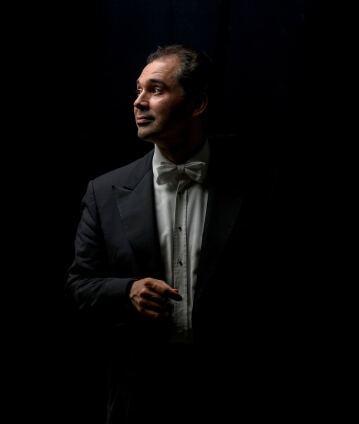Tugan Sokhiev conducts Berlioz’s “Symphonie fantastique”

In his Symphonie fantastique, Hector Berlioz set a dark drama of unrequited love to music with intoxicating intensity. It depicts contrasting scenes in visionary tonal colours: infatuation, a swirling ball, doubts that lead to a murder and an execution, and finally a sinister witches’ sabbath. Johannes Brahms’s Double Concerto is characterised not only by its emotional depth but also by its Classical clarity. The soloists under the baton of conductor Tugan Sokhiev are concertmaster Noah Bendix-Balgley and principal cellist Bruno Delepelaire.
Rome, 1832: Felix Mendelssohn – on a grand educational tour – retrieves an overture he sketched in Scotland to revise. He recalls “how strange [he] felt in the Hebrides,” seasick on the ship off the wave-tossed Fingal’s Cave. The cave inspired him to compose mysterious music that depicts the wind, the waves and the rumble of thunder.
“My relationship with Mendelssohn began in Rome in a rather bizarre way,” recalled Hector Berlioz. After several failed attempts, he finally won the coveted Prix de Rome and now the scholarship holder was enjoying summer in the Eternal City. One evening, he met Mendelssohn at the French Academy. When Berlioz confessed that he was dissatisfied with his Prix de Rome cantata, his colleague replied: “I was afraid that you would be satisfied with this first allegro; to be honest, it’s terrible!”. This marked the beginning of an unusual friendship in which one moment they are making music together – with Berlioz singing, and Mendelssohn accompanying – and the next the German would like to “bite him to death” because he is repulsed by the eccentric Frenchman’s music. The Symphonie fantastique, on which Berlioz was working, reflects his inner life. The lyrical idée fixe, the main theme, embodies his distant beloved – who has no inkling of Berlioz’s affection – whose delicate face is transformed into a grimace in feverish musical dreams – “cold foolishness, cold passions” to Mendelssohn’s ears.
Lake Thun, 1887: Johannes Brahms senses that it is time to bury the hatchet. For seven years, relations between him and violinist Joseph Joachim had been cold, after Brahms sided with his friend’s wife in their divorce. “Prepare yourself for a little shock,” he began his peace offering, “I ask you in all sincerity and friendship not to feel the slightest embarrassment. If you send me a card that simply says, ‘I decline’, I will know enough and how to fill in the rest myself.” The ace up his sleeve? A double concerto for violin and cello that, in addition to the rivalry between the solo instruments, repeatedly creates dialogues of partnership – and even strikes a Hungarian tone in the finale. His “final folly” (Brahms) achieves the desired effect: at the premiere, the two – together with their friend, the cellist Robert Hausmann – finally stand together on stage again.
© 2026 Berlin Phil Media GmbH